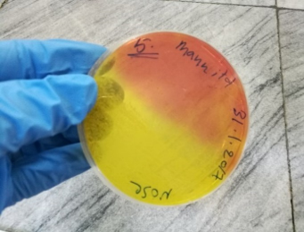Abstract
Detection of mannitol fermenting coagulase-negative staphylococci is frequently unnoticed when Staphylococcus aureus is screening in the laboratory. On the other hand, the emergence of coagulase-negative staphylococci as critical human pathogens need dependable methods for the identification of clinically significant coagulase-negative staphylococci to understand the epidemiology of infections caused by these bacteria. The study aimed to identify mannitol fermenting coagulase-negative staphylococci that assumed to be Staphylococcus aureus as they formed yellow colonies on Mannitol Salt agar plates. Samples were taken from eighty-four patients with diabetic foot infections. The specimen was cultured on Blood agar and Mannitol Salt agar. Mannitol fermenting coagulase-negative staphylococci isolates diagnosed through Vitek2 system then confirmed by detecting 16S rRNA gene and absence of the nuc gene. Antibiotic sensitivity and methicillin resistance were detected by Vitek2 system, then methicillin resistance was confirmed by Oxacillin Salt Agar Screen test and detection of the mecA gene. Out of 81 Staphylococcus isolated from foot and nose of diabetic foot patients, twenty isolates were mannitol fermenting coagulase-negative staphylococci, they related to following species; Staphylococcus haemolyticus, Staphylococcus lentus, Staphylococcus xylosus, Staphylococcus lugdunensis, Staphylococcus hominis, Staphylococcus galinarum and Staphylococcus saprophyticus). The majority of them (85%) were phenotypically methicillin-resistant and genotypically harbouring mecA gene. 80% were resistant to Erythromycin, 70% to Clindamycin, 35% to Trimethoprim-Sulphamethoxazole, 30% to Gentamicin and Rifampicin, 15% to Levofloxacin and Teicoplanin. 30% expressed inducible clindamycin resistance.
Full text article
Authors

This work is licensed under a Creative Commons Attribution-NonCommercial-NoDerivatives 4.0 International License.

